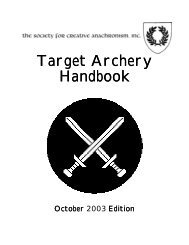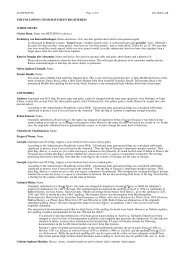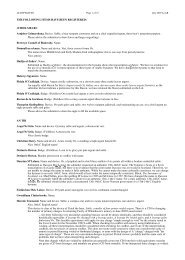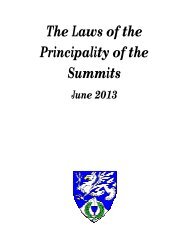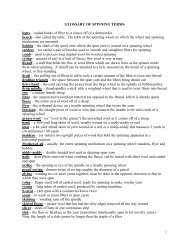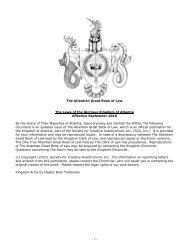The Standards for Evaluation of Names and Armory - SCA Heraldry
The Standards for Evaluation of Names and Armory - SCA Heraldry
The Standards for Evaluation of Names and Armory - SCA Heraldry
You also want an ePaper? Increase the reach of your titles
YUMPU automatically turns print PDFs into web optimized ePapers that Google loves.
<strong>The</strong> <strong>St<strong>and</strong>ards</strong> <strong>for</strong> <strong>Evaluation</strong> <strong>of</strong> <strong>Names</strong> <strong>and</strong> <strong>Armory</strong>:<strong>The</strong> Rules <strong>for</strong> Submissions1. Fielded Designs: We categorize these as devices <strong>and</strong> badges. <strong>The</strong> introduction in A. <strong>Armory</strong> abovediscusses the differences between these two categories. <strong>The</strong> field creates a background <strong>for</strong> charges <strong>and</strong>creates a unified design. <strong>The</strong>re are no limitations to the types <strong>of</strong> charges which may appear in thesedesigns, beyond those in A.2.B above. <strong>The</strong>y may have any combination <strong>of</strong> charge groups that may belegally combined or may have no charges at all.2. Fieldless Designs: We categorize these as badges; devices must have a field. All the charges in thesedesigns must touch one another to create a single self-contained design. Fieldless designs must follow allother style rules. <strong>The</strong>y must include a primary charge, <strong>and</strong> may also include secondary, overall, or tertiarycharge groups. Additionally, no charges may be used that are defined in terms <strong>of</strong> the field or its outline,such as a bordure, chief, or an ordinary that isn't couped.A special subset <strong>of</strong> fieldless designs is tinctureless designs. <strong>The</strong>se designs are those which do not specify atincture <strong>for</strong> the charge or background, such as the English badge, (Tinctureless) A pheon. <strong>The</strong>se designsmay only be registered as seals <strong>for</strong> the use <strong>of</strong> principal heralds <strong>of</strong> kingdoms, although some earlierregistrations to individuals exist.3. Augmentations <strong>of</strong> Honor: An augmentation is a mark <strong>of</strong> honor bestowed by the Crown that is added to anexisting device. An augmentation may not be added to a badge. An augmentation may take many <strong>for</strong>ms,including but not limited to a charged canton, a charged chief, charges in canton or chief, a chargeassociated with the Crown, or a charge associated with the individual receiving the honor.While the right to an augmentation is bestowed by the Crown, its specific <strong>for</strong>m must be determined throughthe normal registration process. Both the augmentation itself <strong>and</strong> the augmented device must follow thestyle rules <strong>and</strong> restrictions on charges. Because an augmentation adds complexity, augmented devices are<strong>of</strong>ten allowed to violate certain style rules, such as allowing charges on tertiary charges or a complexitycount <strong>of</strong> greater than eight, as long as the identifiability <strong>of</strong> the design is maintained. However, they may notviolate the rules on contrast.For example, the arms <strong>of</strong> a branch may not be granted as an augmentation, because they contain a laurelwreath, which cannot be registered to an individual.An augmentation that appears to be a display <strong>of</strong> independent armory, such as a charged canton or a singlecharged escutcheon, must also be evaluated as if the augmentation itself were a submission <strong>of</strong> independentarmory <strong>for</strong> purposes <strong>of</strong> style, conflict, <strong>of</strong>fense, <strong>and</strong> presumption. Kingdoms may designate a badge as ast<strong>and</strong>ard augmentation <strong>for</strong> its subjects who receive augmentations. Such a badge is considered to begr<strong>and</strong>fathered to the submitter <strong>and</strong> does not need to be further checked <strong>for</strong> style, conflict, <strong>of</strong>fense, orpresumption. However, it must maintain good contrast with the field or charge that it is on.B. Armorial Contrast: Contrast refers to the patterns <strong>of</strong> the use <strong>of</strong> tinctures in armory. All armorial submissionsmust meet the st<strong>and</strong>ards <strong>for</strong> contrast as set out here <strong>and</strong> in period practice.1. Tinctures <strong>and</strong> their Classifications: Tinctures are primarily divided into colors <strong>and</strong> metals. Colors <strong>and</strong>metals are said to have good contrast with one another. Each tincture may be depicted in a variety <strong>of</strong>shades; contrast is determined not by their shade, but by their categorization into color <strong>and</strong> metal. Shadesthat are overly pastel may be considered too light to be registered; baby blue is not an acceptable shade <strong>of</strong>azure.<strong>The</strong> colors are azure (blue), gules (red), sable (black), vert (green), <strong>and</strong> purpure (purple).<strong>The</strong> metals are argent (white or silver) <strong>and</strong> Or (yellow or gold). We capitalize Or <strong>for</strong> clarity, but do notcapitalize other tinctures.<strong>St<strong>and</strong>ards</strong> <strong>for</strong> <strong>Evaluation</strong> <strong>of</strong> <strong>Names</strong> <strong>and</strong> <strong>Armory</strong> – April 29, 2012 - Page 40 <strong>of</strong> 73



